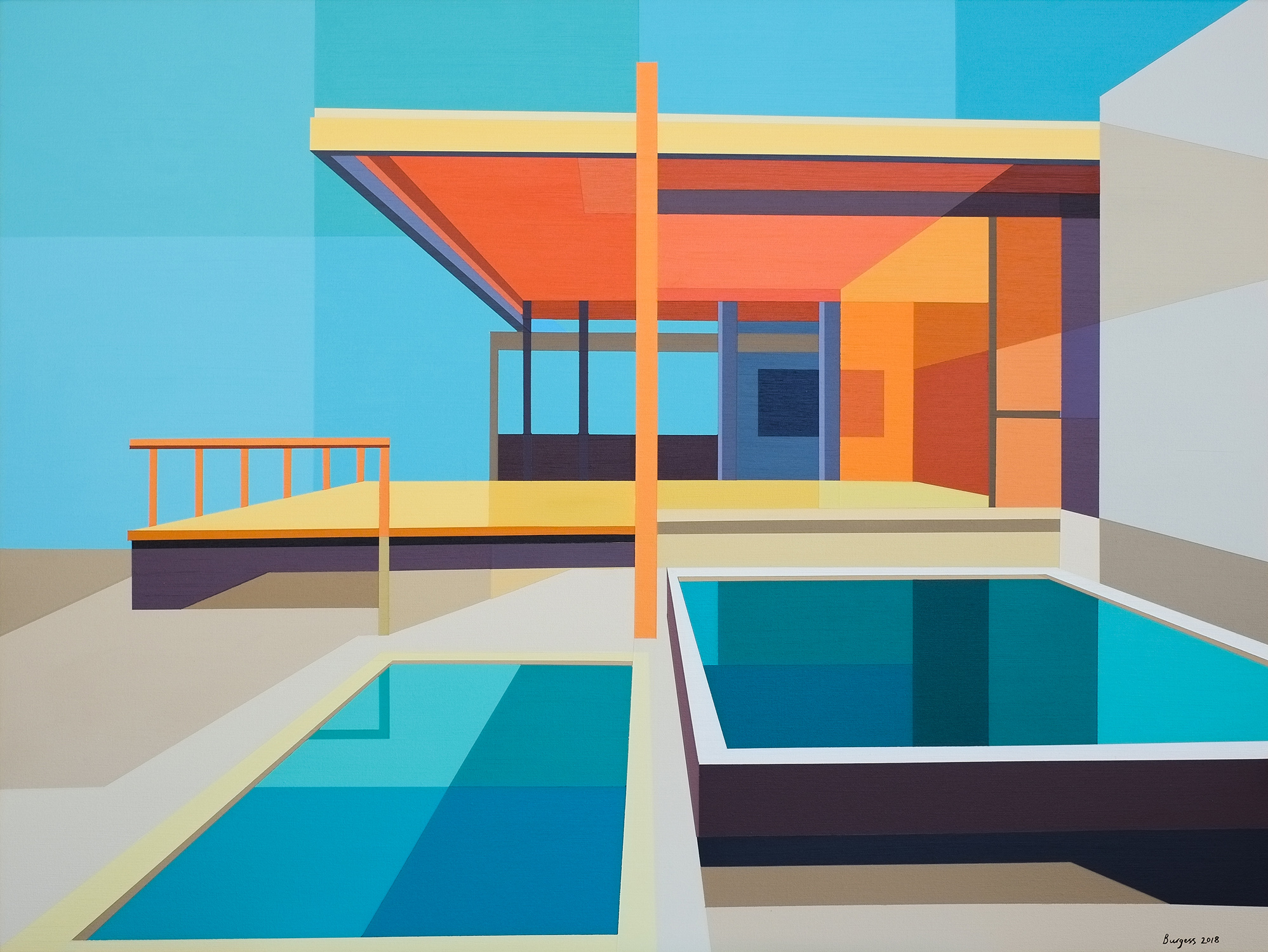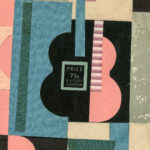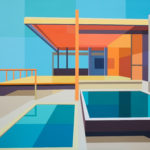Writer Amanda Christmann
Photography Courtesy of Bonner David Galleries
[dropcap]”I[/dropcap] was really tremendously affected by art, and I found that it moved me more than anything else. After a while, looking wasn’t enough; I had to create.”
If art were words, Andy Burgess would be a master of anthologies. He would write about bygone eras in American history one post-war decade at a time, waxing eloquently about their illusory idealism and the rosy hope that has fed the American dream since before statehood.
His words would be provocative and brilliant, and like James Joyce’s “Finnegan’s Wake” or Cormac McCarthy’s “Blood Meridian,” the endings would be ambiguous, their point abstract.
Fortunately, Burgess chose not to delve into the written word, but rather turned to paper, brushes and paints, and a medley of other media to express himself.
This London-born artist is known for his “pop geometry” renditions of modernist and mid-century architecture. With bright bursts of color and the simplicity of clean lines and sharp angles, he marries a wonderfully complimentary combination of cubism, Russian constructivism and art deco styles to create his own brand of retro art.
Whether his work elicits memories or simply a desire to touch base with a romantic view of a halcyon era, it certainly has its devotees.
Represented From London to Scottsdale, his collectors include Booker prize-winning author Kazuo Ishiguro, locally born actor and writer Emma Thompson, the Tisch family in New York, and Richard and Ellen Sandor, who have one of the top 100 art collections in America.
Despite the accolades, Burgess remains unassuming, blending into the downtown Phoenix landscape as we sit in a coffee shop sipping on cactus-themed concoctions. His bearded face is round, and black rectangular glasses are perched atop his nose. He is quick with a smile and his wit is even quicker, but what is most evident is his depth.
As accessible as his work appears on the outside, it doesn’t take long to figure out that both Burgess and his work come from a place much more complex than they appear.
Burgess’ life didn’t begin particularly artistic. He first earned his degree in political science and minored in journalism—both knowledge bases that gave him a great deal of perspective in his life and in his work.
“I found that, when I traveled, I often gravitated to art museums and other places I could look at art. I was really tremendously affected by art, and I found that it moved me more than anything else. After a while, looking wasn’t enough; I had to create.”
And create, he did.
Some of his earliest work was in collage—an art form he still enjoys today. In a nod to Dadaist style, he began to use vintage papers, cigarette labels and matchboxes from the 1930s to create city scenes—clever parodies of buildings of the time that often had advertisements painted on their sides.
Never one to commit to a single medium or idea, he also dedicated himself to painting, experimenting with everything from oils and acrylics to watercolor and gouache.
As he painted, his now-signature style began to take shape.
“I was always into architecture,” he explains, “partly because I love the abstraction of the receding plains and the geometry. I started to explore modernist architecture back when I still lived in London, but when I moved to the American Southwest, I got into American-style mid-century modern, which was a similar style but adapted to the desert.”
That adaptation fascinated him, taking him to explore areas like Phoenix, Tucson and the Southwest’s mid-century mecca, Palm Springs.
“I started to paint houses with swimming pools, glass, steel beams and some of the other features my work has become known for. The vibe is a little bit glamorous, a little bit aspirational.”
His paintings, full of vibrant colors and radiant light, are easy to spot, in no small part because of the vivid representation of something nostalgic. Interestingly, there are never people in his paintings, but there are often representative objects—an automobile here, a piece of furniture there. The nuance is by design.
“The reason I take people out is because paintings are fiction. They’re part real, part invented. When you take the people out, the viewer has to provide their own narrative.
“It’s like stepping into an empty theater. The stage is there, but there are no actors on stage. That means the viewer has to do more work. It’s more ambiguous and open to interpretation. I like to leave people out because I don’t want to make it that obvious.”
Now a Tucson resident, Burgess is a self-proclaimed fan of film noir settings. His work does not reflect the fatalism of that genre so much as it expresses the joie de vivre of an era all but lost to commercialism and technology. Neon signs, swimming pools and brilliantly manicured lawns are all part of the allure.
“I’m interested in exploring nostalgia rather than being nostalgic,” he explains, taking a swig from his straw before continuing.
“If I paint a vintage car, it is because it was actually there and I really saw it. I’m interested in the fact that it is still there, and the fact that we are still attached to it, or lamenting that it might disappear.”
That fascination is what draws Burgess to vintage signs, old papers and other elements of the past that come to life in his art, though they are slowly being replaced in our current world.
As the vestiges of the past disappear, Burgess seems more determined to document their cultural relevance.
Among his most recent works are additional paintings, as well as a series of cubist collages done in homage to the assemblage of guitars Picasso made, first in cardboard, then in sheet metal, in 1912 and 1914.
He has also delved into photography, compiling a book of photographs shot in Italy, Portugal, New York and London. At first glance, they seem entirely different from his telltale style. To begin, there are people in many of the pictures. Look closer, though, and their narratives contain the same figurative question marks as his other work.
Most recently, he has released a limited edition hardback book called “Modernist House Paintings,” published by the highly regarded Nazraeli Press. It’s fascinating to look at, and the foreword offers excellent insight into both the artist and the work.
As he continues to create and experiment with new ideas, Burgess is opening Bonner David Gallery’s first show of the season Sept. 27–Oct. 15. His modernist and mid-century architectural works and cubist guitar collages will be on display, and he will be available in person to discuss his art and sign his new book.
As for what is next, not even Burgess knows.
“I have always been completely obsessed by photography and I’m working on a major portfolio and several book projects, and I will still be painting, of course. I’m moving slightly into 1970s architecture. I like the peculiar shapes of the buildings and the circular patterns, and they tend to be colorful. At the same time, I’ve been doing modernist and post-modern house paintings for 10 years and I still have a lot in me.”
And with any luck, he does.
Andy Burgess Artist Reception and Book Signing
Thursday, October 11
6–9 p.m.
Bonner David Galleries
7040 E. Main St., Scottsdale
RSVP Required
Free
480-941-8500










Comments by Admin